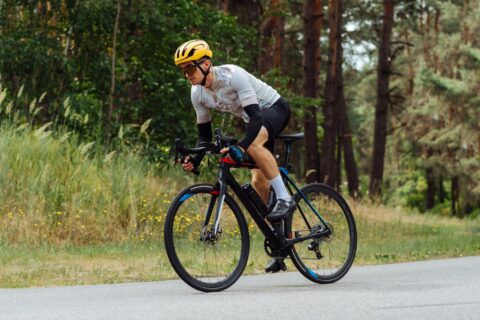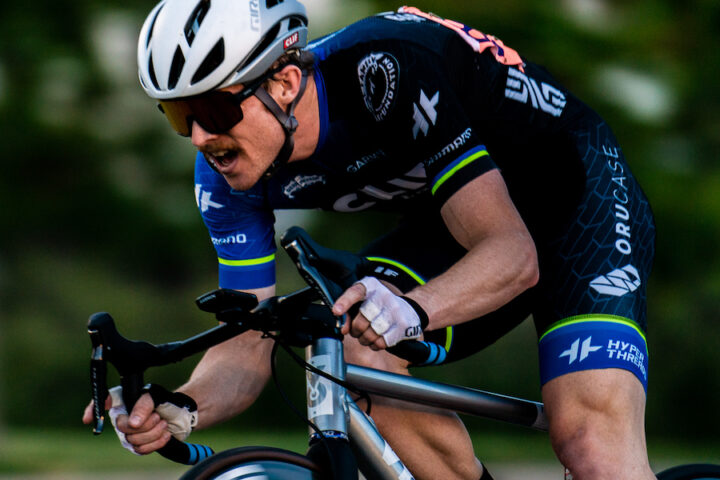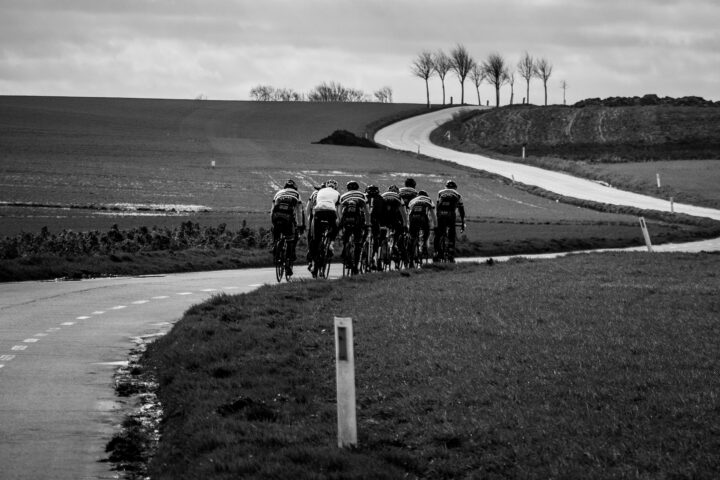At what intensity should athletes perform long, slow distance workouts? Dr. Stephen Seiler lays out a method for athletes to figure out their own, ideal intensity and duration for low-intensity workouts.
Video Transcript
Dr. Stephen Seiler 00:01
Hi, this is Dr. Steven Seiler. As many of you know, I am an enthusiastic explorer of the endurance training process. I do research in the laboratory and in the field. I engage in conversations and consulting with coaches and athletes, and I’ve sweat myself and try to understand how things work as I exercise and train pretty regularly. And in all of these arenas, one of the things we have come to understand from studying athletes, studying the training process is that the low intensity below lactate threshold component of our training, that part of our endurance training is extremely important. It lays the foundation for success and high performance athletes into most of their training volume at a low intensity. Meaning for them, a pace, they can sustain a long time, a pace that they can sustain and have a conversation while doing so.
Common Questions People Have Behind Low Intensity Training
Dr. Stephen Seiler 01:11
But questions arise regarding how this training should be optimized? What intensity? What in what duration? These questions emerge. How low is too low? How low of an intensity is too low to give a good training stimuli? And, by extension, how long have a training session is too long? When does the training duration become optimal? When does it exceed that and create more stress than it provides additional stimulus? So these are important questions, and the spoiler alert already is we don’t know. We don’t have data that we can throw down on the table that tells us very precisely what these answers are. But we can begin to explore these questions, and we are this is an area that I want to spend quite a bit of time on in in the future.
What Does Low Intensity and LIT Training Mean?
Dr. Stephen Seiler 02:20
Now, if you’re going to talk about in training, you have to understand what intensity you’re talking about. What what do we mean by low intensity or LIT training? Well, we mean that the training is below this first lactate threshold in a three intensity zone model, which is the physiological model that has emerged from research over many decades. This is the the three zones that emerge and the low intensity zone is demarcated by the first increase in blood lactate or also the first ventilatory threshold if you use laboratory ventilatory and gas exchange measures. Now, is this important? Well, it turns out, yeah when we crossed this threshold, quite a bit happens physiologically, not only an increase in blood lactate, but an increase in cortisol, the overall stress response, perceived exertion changes pretty significantly. Recovery of autonomic nervous system function after training is slowed. So we have quite a bit of data really say that there is there are real changes that occur. So that so that when we intend to train at low intensity, we need to get that intensity right. Now, in coaching practice, there are often many more intensity zones than just the three that are more pervasive in the research literature. You may see five zones, you may see six or eight or nine, depending on the national governing body that you work with or the guru that you adhere to. Because let’s face it, these zones are somewhat arbitrary, and probably have more pedagogical and practical value than any clear physiological distinctions once you start to cut the pie up in very small pieces. And then there is this additional boundary that is discussed as I introduced, and that is this lower boundary for zone one in these models. Where is that? At least in the three zone models, zone one is a effective training zone. It’s not a recovery training zone. But where how low is too low, and again, I think already we can say that this is one of those classic, “it depends kind” of answers that you can expect from the Sport Science. And I know coaches and athletes do not like answers that begin with “it depends.” But such as life, physiologic-physiology is complicated. Training is pretty simple, but physiology is complex. However, we’re going to try to delve into this.
Three Basic Tools to Monitor Training
Dr. Stephen Seiler 05:30
Now, if we’re going to monitor training and try to examine workloads, then we have these three basic tools. We have the external work that can be pretty precisely measured, we can measure power in cycling, we can measure power in rowing, we can measure velocity or pace in running. So we have these tools to give us an external work measurement, and then we connect that to the internal cost of generating network. And that can be achieved both with physiological measurements like heart rate, and blood lactate in the field, and some additional measurements in the laboratory such as oxygen consumption. And then we have perception, the brain is aggregating information from the musculature from the body, and also is in a feet forward manner, generating perceptual information as muscle is recruited. And the sum of all this, gives us an understanding is our brain an understanding of how hard we are working in the Borg scale is a is a tool for putting a number to that-t hat construct that is developed in the brain. So that’s one of the popular tools and there are others. But these are the three monitoring measurements. This is our triad that works in concert with each other. They they complement each other and support the strengths and weaknesses of each measurement.
How This Process of Tracking Training Levels in the Lab Works
Dr. Stephen Seiler 07:09
Now, I’m going to focus on these two today and the relationship between them. If you do a laboratory lactate profile, as you see here, you would have the athlete it work at successively greater speed or power. He would carefully and precisely measure heart rate, blood lactate, perceived exertion and so forth, at specific times in each of these steps, and then you would be able to detect a nonlinear change and you can see that in blood lactate. And then use this as a guideline for training, and these values are based on fresh warmed up athlete is coming in, coming into the laboratory fresh and leaves the laboratory after an hour tops. So this is their, their rested physiological state.
How to Measure Levels if you Don’t Have Access to a Lab
Dr. Stephen Seiler 08:07
And if we can’t get in the lab, there are other ways of trying to estimate whether or not the athlete is in these different zones. In the green zone, they are able to speak comfortably. Heart rate flattens out after 10 or 15 minutes once core temperature stabilizes. Blood lactate is the same, it stays low and it’s flat. When they go into the threshold, we see a rising heart rate not to max but but a significant elevation or drift in heart rate. We see blood lactate being elevated in the restabilizing, and we see as they enter into that third zone, that high intensity zone, we see this continuous increase in blood lactate towards exhaustion, and we see heart rate will eventually approach maximum values.
Training Data From Elite Orienteers in Norway
Dr. Stephen Seiler 09:02
Now, here’s some data from Elite Orienteers in Norway. These were very highly trained, training twice a day and several of them were elite performers, including a world champion. And we asked them to do four different training sessions to blow their first lactate turning point. Either 60 minutes long or 120 minutes long, and then a third threshold session and a high intensity interval session. So you can pause the data or pause the video and just look at the data because it’s gives you some ideas about what the basic physiological responses are at these different intensities. But for my purposes now, I want to show you that when these athletes did a 60 minute run or a two hour run at the same intensity, there was no difference in their physiological responses, between one hour and two hours. No difference in their perception, nearly blood lactate stayed flat heart rate stayed the same. So they had very stable physiological responses, at least through two hours of work at this intensity, and several said to me after that 120 minutes session, they felt better after they did when they started. So they clearly, these well trained athletes have a very well developed ability to perform at low intensity for a long time without a big change in the physiological demand that imposes on them across that duration. And this is something we want to understand because the laboratory tests of VO2 max, of the lactate threshold, of work deconomy, or efficiency do not capture some important adaptations that seem to be decisive in the careers of endurance athletes.
Durability Questions
Dr. Stephen Seiler 11:09
Whether we’re age groupers, or world class athletes, as we continue to develop a lot of our improvement involves something we’ll call durability, and another feature we’ll call repeatability of power and pace. Low intensity, durability, I will define is the duration or the ability to work over a long duration at a given sub threshold pace or power, without a significant increase in physiological and also perceptual cost. How long can we maintain that low intensity duration, without it becoming overwhelming? Becoming high intensity in a sense, and the second is high intensity repeatability. The ability of the athlete to repeat periods of work above the second lactate turn point. Or you can choose the critical power or the maximum aerobic power, depending on what you want to use as your physiological redline. But how often and how well can the athlete repeat these surges in pace or increases in power on climbs during training, or during a race without deteriorate- deterioration of the performance.
Where These Terms and Concepts Came From
Dr. Stephen Seiler 12:42
And I have to say that these terms and these concepts have kind of emerged from discussions with a lot of people, coaches and athletes, but particularly, I want to give some credit to a guy named Trevor Connor, who I’ve done some podcasts with and in in our discussions, drawing on his coaching and performance experience, and my research experience, these terms really resonated for me. And so I thank him for helping me with them, and now I try to quantify them and understand that how they develop in a physiological perspective.
How Dr. Seiler Got Back in Shape After a Leg Injury
Dr. Stephen Seiler 13:23
And here’s an example, this is yours truly getting back in shape after a significant leg injury, starting the cycle again, after many years off the bike and-and you see data from December 2018, where I performed at a steady 205 watts for three and a half hours. And you see that for about the first 90 minutes, my heart rate stayed constant. But then it began to drift upward in this idea of cardiac drift as well known and discussed in both the research literature and in the coaching. Now, if you go six months later, in May of 2019, at the same 205 watts for three and a half hours, I was able to perform longer before the drift really kicked in, and the magnitude of that cardiac drift was lower. Even though temperature, drinking everything else, a big fan blowing on me all of those things were the same. So I would interpret this as I improved my low intensity, durability during those six months of training, a lot of of low intensity and increase in my volume of training. Now, I looked at that in a kind of a crude way and was able to see a difference but it definitely inspired me to say “I need to be able to quantify this in a in a much better way that’s comparable across time and across people.”
How These Measurements and Tools Emerged with the Help of John Peters
Dr. Stephen Seiler 15:00
And fortunately, I was already working with John Peters from the UK who is a veteran runner, and had developed some applications related to running. And I was able to pull him into this task, which was to be able to work with these data files and draw out some of the information that comes by looking at these variables like heart rate and power up against each other across time. So this tool has been developed, we’ve been working on it since we have for about eight months now, and it has finally gotten a name.
Endura
Dr. Stephen Seiler 15:35
The name is Endura. It’s still just a tool that we use, but we’re slowly trying to get it ready for others to be able to use as well, and it’s basically Endurance, Durability and Repeatability, and Analytics. And so I will be showing you some data from this application. Now, one of the concepts that’s kind of infused into the analytics application is the concept of heart rate reserve. This is the old carvone formula, heart rate reserve equals the maximum heart rate minus the resting heart rate. That is the number of beats that you have available to you, during exercise. Your resting heart rate represents a baseline value that you that you don’t go below.
Data Formed From Endura
Dr. Stephen Seiler 16:33
So in this case, we have an athlete that has a resting heart rate of 37, a maximum heart rate of 187. That means she has a heart rate reserve of 150 beats per minute. Now both the max and the resting heart rate for this athlete are low compared to what we might expect. But-but actually it’s not that unusual, and it just speaks to the fact that we need to have individual values and not estimates on these things. Here’s another, I guess we’ll call him an athlete, this is me, a maximum heart rate of 165. Also a low resting heart rate of 36. An older athlete, I have a in this case, I have a smaller heart rate reserve in terms of number of beats. But this gives me a calibration. I know that about 13 beats corresponds to 30- 10% of my aerobic capacity, and during low intensity training. For example, here, this is actually my daughter, she’s doing up above you see a 80 minute, easy run and heart rate stays quite flat in zone one of a five zone model here. Even though she’s kind of there’s a little bit of incline and so forth. So she is staying below this threshold from the laboratory, and here’s more data, this is from me, extremely boring, two lines that are basically going on top of each other or in parallel. One is my heart rate expressed as a percentage of that heart rate reserve that I defined for you, and the other is the power I am producing on the bike, and it’s expressed as a percentage of actually my six minute maximum power. In this case, I’ve called it maximum aerobic power, those two tend to be pretty close to each other as a surrogate measure. And in my case, when I’m rested, and when I’m doing low intensity. They basically, the ratio between them is basically one. So 50% of my heart rate reserve corresponds to me working at 50% of my maximum aerobic power, roughly. In here, you see that in the numbers, expressed as a ratio of percentage heart rate reserve to six minute power, and then that means it’s possible to see if that ratio changes across time during a session.
Dr. Stephen Seiler 19:24
Here is a three hour steady state ride at 195 watts that basically same intensity and still it stays flat and in no clear cardiac drift across three hours at that intensity. But or, if I go to two hours at 220 watts, I’m still after two hours able to show that I’m below the lactate threshold. I am not showing cardiac drift. You see that that ratio between heart rate reserve and six minute power may be drifts up just a little bit, but overall stays very close to one across two hours. But now when I move to four hours at the same power, now we see the first two hours go well, meaning that this ratio stays the same. You see that heart rate and power relying on top of each other. But then at about the two hour mark, we start to see a dissociation between the internal workload, which is heart rate here, and the external, which is power here, and that gap seems to be widening. And we can put a number to the when I break this for our ride up into 20 minutes segments, and here, you see that ratio across time, and it is changing. It begins close to one as it has in the previous rides you showed, then it starts to drift upwards, and then in the last hour or so it is at about 20% higher meaning the significant increase in heart rate relative to the initial load. And this is despite having a big fan blowing, low temperature in the room drinking at least one bottle of fluid every hour, and so forth. So clearly, this low intensity session became quite demanding towards the end for me.
Tim Podlogar’s Training Levels
Dr. Stephen Seiler 21:47
Now, here’s a better cyclist. This is a guy named Tim Podlogar from, uh he. I met him when he was a PhD student at the University of Birmingham. I think he’s returned to Slovenia now. But he’s far better athlete here. He is doing, for him also a low intensity session just below his first lactate turn point. He rides for five hours indoors, on an odometer modus bike. So the power is very stable at 250 watts. Now, in this case, he was in the vestibule of a building, he was doing some talking along the way to passers by. I think there was some oxygen consumption testing going on periodically. So there’s a bit of a drifted heart rate up and down along the way when he has to talk, and so forth, and just some of the stress of that. But overall, you all-you would have a nice clear pattern of drift that he shows, and here’s that same ratio for him. Now, what you might immediately see is, well, he’s not at 1.0 when he’s starting. He’s already from the start at a higher ratio. Now is this because he’s fatigue? No. It’s probably because just his, the relationship between stroke volume and heart rate for him is a bit different at the lower intensities, and then it is for me, and so we need to know his baselinei f we’re going to make this comparison. That means we need another way of indexing this, and we need to have a number that we say this number is now our starting point is our calibration. So we let it warm up for 20 minutes, and then we have a value from 20 to 40 minutes, that we’ll call his baseline internal to external relationship. And when we do that and call that one, then we can go through the same process, as you saw with me, and you see that he shows the same. He shows a cardiac drift relative to his baseline, it’s more subtle than mine. But he also told me that after five hours, he was completely shattered. So this smaller drift is still indicative for him of a very significant fatigue and a significant direct deterioration of his capacity over time, over five hours.
The Index, or NXS
Dr. Stephen Seiler 24:24
Now, what this means if we go back to my data that we can, we need an index that allows us to quantify workouts from day to day where there can be small changes or changes in our fitness over time. So we need to be able to calibrate for that and we need to be able to compare across individuals. So we’re using heart rate reserve, we’re using percentage of six minute power as his calibration tools, and then we have this index measure that we can apply. And I’ve given that index just a name, NXS. Reminds me with a band from the 80s. But it is the relationship between the internal and external workload as a kind of a stress indicator.
More Data From 10 Athletes
Dr. Stephen Seiler 25:14
Now, here’s some more data. This is from 10 athletes. We’ve got quite a bit of data coming in from athletes that are performing four hour rides as we speak. And here is their percentage of heart rate max across four hours, performed as at a steady power of between 60 and 70% of their 60 minute power. And they were allowed to choose where within that range, they wanted to stay for these four hours. And you see, on average heart rate is about 65% of their maximum heart rate at the in the first 10% of the period. And by the last 10% of the four hours it’s increased to 74%. But there’s some variation across riders, and if we look at this as this shift in heart rate across time, we can see the graph above, and we can see the mean change. So on average, they’re at about one, as I suggested. But, there’s variation around that from about point eight five to 1.2 as their baseline, and then that ratio tends to go up across time. And you see that here. So they, as a group show very much the same kind of response that you saw with me, and with Tim Podlogar, individually. And then if we ask them their perceived exertion along the way, which we are doing, we see that in this group already, we know that at first it starts very low 10 is is low on the RPE scale. But by the time they’ve been riding for for four hours at this low intensity, they are now perceiving it to be hard. So there’s a clear increase in perceived exertion that matches that heart rate change. And in fact, if we take two riders as examples, there can be considerable variation. This is rider one has very little heart rate change and a pretty low perceived exertion, and that doesn’t drift too much and become too high. So even at the end hours, he’s saying it’s a 12 verses rider or nine, who begins also perceiving the work to be very easy. But by the end, he is saying this is an 18, which is that’s the kind of number that athletes report at the end of extremely tough interval sessions.
The Factors That Influence Shifts in Workload During Low Intensity Training
Dr. Stephen Seiler 27:50
So what are the factors that could influence this internal, external shift in work- in workload during low intensity training? Obviously, one is temperature and humidity, if the body cannot get rid of heat, then there will be more cardiac drift. Even if the musculature is you might say, good to go. Ventilation is important, you need big fans if you’re working indoors. If you don’t have air movement around you, like you do when you’re cycling or running outside, so this is important. Hydration is important over time, for sure. Blood glucose concentration if-if blood glucose begins to decline that will clearly result both in failure, meaning the athlete will just stop riding or running eventually, but also in a deterioration in a cardiac drift. Glycogen storage is important if obviously, if the athlete starts with low glycogen stores, that can accelerate the onset of cardiac drift because of changes in muscle fiber recruitment. Prior fatigue is hypothesized if they did a six hour ride the day before that had a lot of hard work, then a new four hour session the next day would be impacted. How that occurs and the mechanisms, well, we need more data on that. Nutritional adaptations may influence this durability aspect. Training status, certainly we think influences it but we need to collect more data on different groups of athletes with different training backgrounds to-to quantify that relationship. And fiber type composition probably also impacts has-how durable an athlete is and perhaps even can become.
How Low is too Low?
Dr. Stephen Seiler 30:00
Now, one of the things I said at the start was this question of how low is too low, and so if you see an-a ride like I did here, three hour ride at 100, and about 95 watts and a heart rate of, on average 99 is that a useful training session? A heart rate of 99 seems terribly low for an endurance training session. However, we have to calibrate that because my resting heart rate is 36, my maximum heart rate on the bike is 165, so I’m using 50% of my heart rate reserve working at a little bit higher six percentage of my six minute power, and I’m working at 60% of my maximum heart rate. But if we compare me with an imagined rider, with more typical numbers, like a max heart rate of 188, a resting heart rate of 60. Also, working at the same percentage of heart rate reserve, their heart rate would be 124. Well, that’s, that’s a number we would say, yeah, that’s that sounds about right for a low intensity session. And that would be 66% of heart rate max. So we’re both working at the same relative intensity from a cardiovascular mobilization point of view, even though our heart rates of 25 beats apart. This is important, and it speaks to another issue. Which is if you use some kind of a standard formula, like 220 minus age to estimate your maximum heart rate, or you estimate your low intensity heart rate with something like 180 minus age. You will be subjected to a pretty big chance of missing the mark. In Texas, we’d say you’d be kind of like being blindfolded and aim towards the broadside of a barn and then told to shoot and hit the little saucer hanging on the on the wall there. Chances are you will hit the barn, but you’re very unlikely to precisely hit the mark, and you may break some windows. So measure these values if you’re going to use heart rate as a tool for intensity control.
Dr. Stephen Seiler 32:25
Now, what is the minimum, low intensity, intensity, or green zone intensity, that still gives an adaptive benefit? You knew I was gonna tell you, it depends. And it probably depends on the duration times the intensity, because intensity doesn’t work in isolation. It is a function also of the duration, we ride it. So a 60 minute ride at 50% of heart rate reserve versus a five hour ride if 50% of heart rate reserve can be very different from a training stimulate point of view, or adaptive signal point of view. And also the baseline for the athlete, what is their typical long, low intensity session duration? Is it 60 minutes? Is it two hours on the bike, four hours on the bike or two hours running versus 60 minutes running? Well, that’s going to impact how long they need to go in order to get an effective adaptive signal.
Dr. Stephen Seiler 33:30
And if we look at that, in the context of typical dose response thinking from medicine, we know that in medicine, if we choose the appropriate effective dose, we’re not going to choose the maximum dose because usually medicines have side effects as well. So we’re going to try to find a very effective dose that at the same time has a low risk of side effects, and if we apply that thinking to the training process into these low intensity sessions, then we can kind of frame it this way that we need to know what is the typical long duration session for this athlete. Because we can assume for example, with me, if I am used to doing two hour rides 60 to 65% of VO2 max, doing one of those rides will maintain my current level of fitness but will not continue to extend my durability. I’m going to have to go longer to do that. But how much longer? Well, using some of these principles of internal load versus external and that shift it as well as perceived exertion we can start to tune in, and for me, I can say well, a three hour ride at this intensity is manageable. It will give me a good stimulus right now relative to where I am, in terms in terms of my typical training volume, but four hours is doable, but it will stress me it will create a big stress response and it will increase the time I need to recover. So I’m probably not going to do that kind of session very often because the benefit may not be in proportion to the cost.
Quantifying Low Intensity Durability
Dr. Stephen Seiler 35:22
So here’s a quick summary of this idea of quantifying low intensity durability. One, low intensity durability is a measure of stability or deterioration in the internal to external workload relationship. Here, I’ve kind of given it a name call it NXS. But whatever the baby is named, the idea is the same. Cardiac drift is a useful tool to try to quantify this, but it needs to be calibrated for comparison, and most of the cardiac drift measures I’ve seen have not achieved a good calibration for comparison, within the same athlete or between athletes over time. The percentage of heart rate reserve and the percentage of six minute power appear to be useful as calibration, scaling mechanisms. We also have to understand that the different mechanisms inducing this instability or this shift upward in internal load versus external load, we need to understand these mechanisms and control for them when we’re interpreting data. And finally, the low intensity durability is highly variable across endurance athletes, but it’s also very trainable. It is one of the areas where we can improve over a long period of time. And our our low intensity durability creates the platform for high intensity repeatability, and that’s what wins races. So we’ll be talking about that more in the future. In the meantime, thank you this has been Steven Seiler. You can join me on Twitter, and you may find that there are some other videos on my channel that are useful for you in this same discussion. Thanks a lot.





